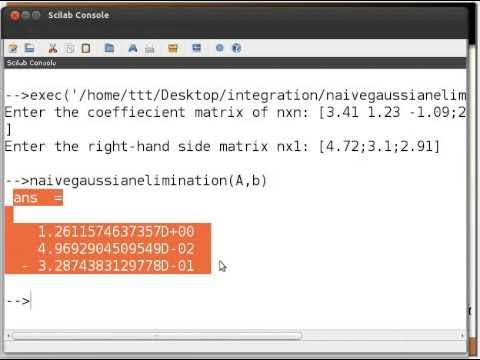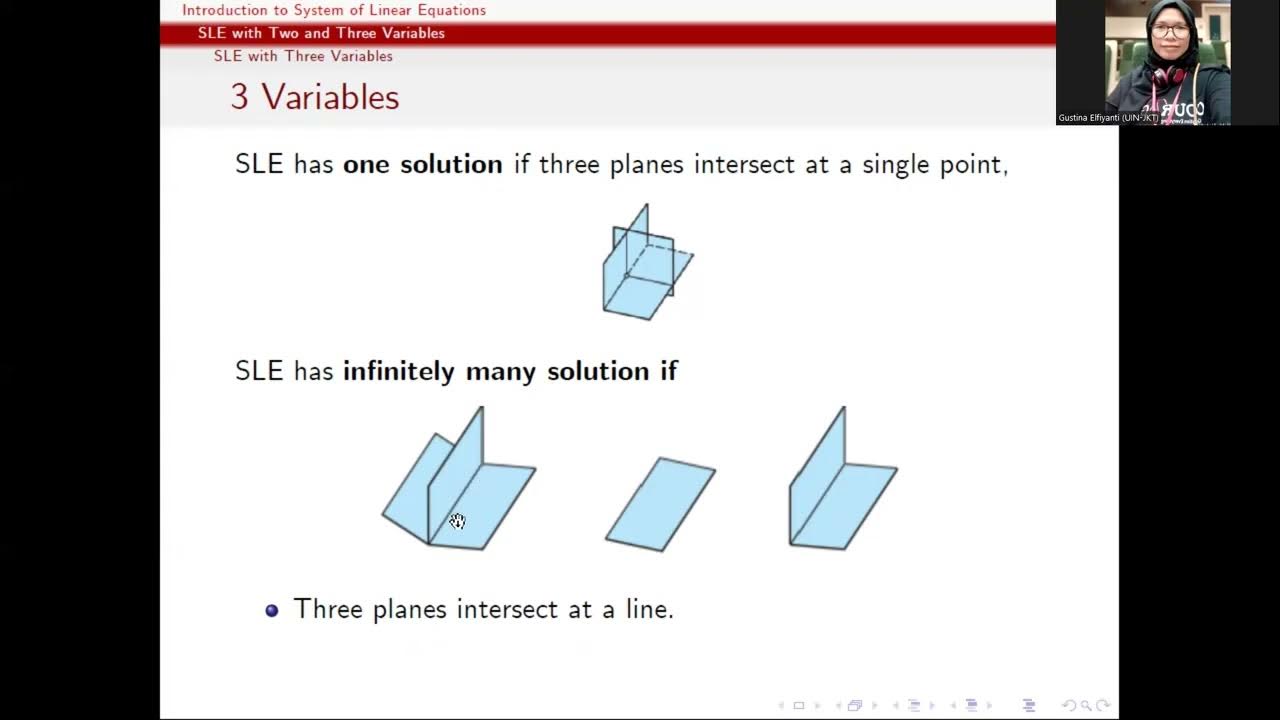SERI KULIAH ALJABAR LINEAR ELEMENTER || IMPLEMENTASI GAUSS JORDAN PADA MASALAH COMPUTER SCIENCE
Summary
TLDRIn this video, the lecturer demonstrates how to solve a system of linear equations using the Gauss-Jordan elimination method. The case study revolves around a tech company allocating computational resources across three applications, each requiring data processing, storage, and user interaction. The system of equations is translated into matrix form and solved through step-by-step row operations, including row swaps and scalar multiplication, to reduce the matrix into reduced row echelon form (RREF). The final solution provides the resource allocation for each application, showing how Gauss-Jordan is applied in a practical context.
Takeaways
- 😀 The video explains how to solve a system of linear equations using the Gauss-Jordan elimination method.
- 😀 The case study revolves around resource allocation for three computer applications (A, B, and C) that need computational resources for data processing, storage, and user interaction.
- 😀 The system of equations is derived from the resource requirements of each application, resulting in three linear equations for three unknowns.
- 😀 The system of equations for the three applications is: 3x₁ + 2x₂ + x₃ = 22, 2x₁ + 3x₂ + 2x₃ = 23, and x₁ + 2x₂ + 3x₃ = 18.
- 😀 The Gauss-Jordan elimination process begins with converting the system of equations into an augmented matrix, which includes both coefficients and constants.
- 😀 A key part of the Gauss-Jordan method is transforming the matrix into row echelon form (REF) by performing row operations such as swapping rows or multiplying rows by constants.
- 😀 One of the key steps in Gauss-Jordan elimination is creating a leading 1 (pivot) in the first column, followed by eliminating values below it using row operations.
- 😀 The goal is to continue reducing the matrix until it reaches reduced row echelon form (RREF), where each leading entry in the row is 1, and all other entries in the column are 0.
- 😀 The final solution of the system is found by back substitution. In this case, the values for x₁, x₂, and x₃ are calculated as x₁ = 9/2, x₂ = 3, and x₃ = 5/2.
- 😀 After solving the system, the results represent the allocation of computational resources required for data processing, storage, and user interaction in the applications.
- 😀 The Gauss-Jordan elimination method results in a unique solution for the system of linear equations, demonstrating the power of this method in solving real-world resource allocation problems.
Q & A
What is the main focus of the video script?
-The video focuses on solving a system of linear equations using the Gauss-Jordan elimination method, applied to a case study involving the allocation of computational resources for three software applications.
What are the three tasks each software application needs to perform?
-Each application must handle three tasks: data processing, data storage, and user interaction.
What is the goal of the case study presented in the script?
-The goal is to determine how much computational resources (in units) each software application requires for data processing, data storage, and user interaction.
How is the system of linear equations formulated from the case study?
-The system of equations is formulated as follows: 3x1 + 2x2 + x3 = 22 (for application A), 2x1 + 3x2 + 2x3 = 23 (for application B), and x1 + 2x2 + 3x3 = 18 (for application C), where x1, x2, and x3 represent the units needed for data processing, data storage, and user interaction respectively.
What is the first step in solving the system using Gauss-Jordan elimination?
-The first step is to represent the system of equations as an augmented matrix, which includes the coefficients and the constants from the right-hand side of the equations.
What is the purpose of creating a leading 1 in the first row during Gauss-Jordan elimination?
-Creating a leading 1 in the first row simplifies the elimination process for the rest of the rows, helping to systematically reduce the system to a more solvable form.
Why does the script suggest row swapping instead of dividing the first row by 3?
-Row swapping is suggested to avoid working with fractions, as dividing by 3 would introduce fractions that some might find more difficult to work with.
How does the script handle eliminating non-zero values below the leading 1 in the first column?
-The script uses row operations to eliminate the values below the leading 1 by multiplying the first row by appropriate factors (such as -2 and -3) and adding them to the second and third rows, respectively.
What is the purpose of backward elimination in the Gauss-Jordan method?
-Backward elimination is used to eliminate non-zero values above the leading 1s in each column, ultimately reducing the system to its simplest form, where each variable corresponds to a unique solution.
What does the final matrix represent after Gauss-Jordan elimination?
-The final matrix represents the reduced row echelon form, where each row corresponds to a variable with a clear solution. In this case, the solutions for x1, x2, and x3 are 9/2, 3, and 5/2, respectively.
What does the script suggest about the uniqueness of the solution?
-The script emphasizes that once the system is reduced to its final form, the solution is unique. In this case, the system of linear equations has a single solution: x1 = 9/2, x2 = 3, and x3 = 5/2.
How do the values of x1, x2, and x3 relate to the resource allocation for the applications?
-The values of x1, x2, and x3 represent the units of computational resources needed for data processing, data storage, and user interaction, respectively, across the three applications.
Outlines

هذا القسم متوفر فقط للمشتركين. يرجى الترقية للوصول إلى هذه الميزة.
قم بالترقية الآنMindmap

هذا القسم متوفر فقط للمشتركين. يرجى الترقية للوصول إلى هذه الميزة.
قم بالترقية الآنKeywords

هذا القسم متوفر فقط للمشتركين. يرجى الترقية للوصول إلى هذه الميزة.
قم بالترقية الآنHighlights

هذا القسم متوفر فقط للمشتركين. يرجى الترقية للوصول إلى هذه الميزة.
قم بالترقية الآنTranscripts

هذا القسم متوفر فقط للمشتركين. يرجى الترقية للوصول إلى هذه الميزة.
قم بالترقية الآنتصفح المزيد من مقاطع الفيديو ذات الصلة

SPLTV #Part 7 // Metode Eliminasi Gauss // Metode Eliminasi Gauss Jordan // Gauss-Jordan

Linear equations Gaussian Methods - English

METODE NUMERIK P2 | METODE GAUSS UNTUK MENYELESAIKAN SPL

SPLDV - Metode Eliminasi

Introduction to SLE

SPLTV #Part 4 // Metode Gabungan // Sistem Persamaan Linear Tiga Variabel
5.0 / 5 (0 votes)
